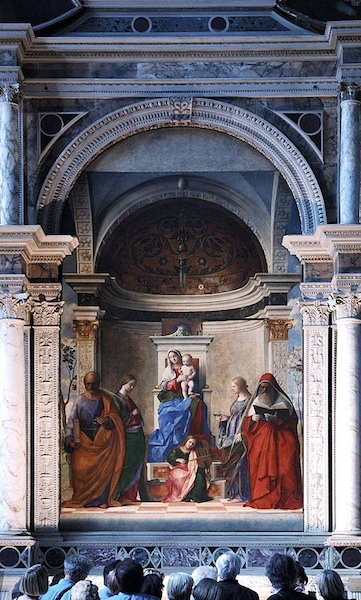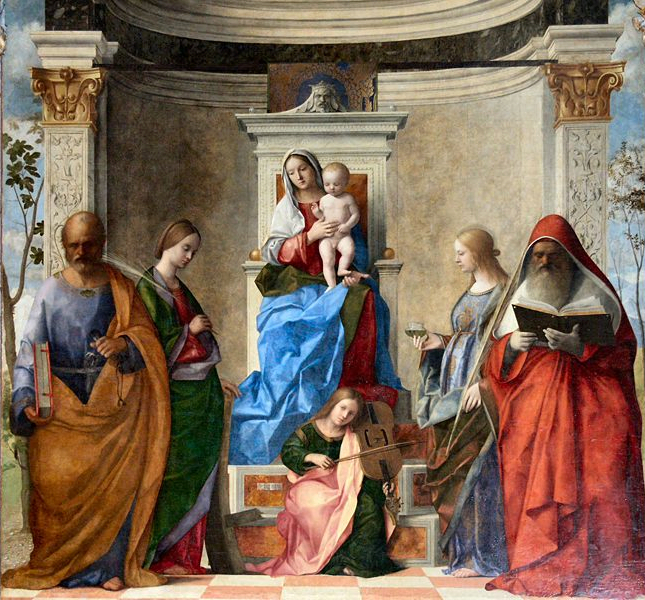What better way to celebrate Christmas than by contemplating this sublime altarpiece by the celebrated Venetian artist Giovanni Bellini? It hangs above a sidechapel in the church of San Zaccaria in Venice offering blissful relief from the noise and bustle of the narrow streets around San Marco.
Listening with quiet concentration is one of the themes. Virgin and child sit on a raised throne absorbing the music played on a violin by an angel seated below them. With similarly downcast eyes, the saints standing on either side seem lost in thought.
The saints are so immersed in reverie that, in effect, they appear absent
This grouping is know as a sacra conversazione (sacred conversation), an odd name for a cluster of people paying scant attention to one another. One of the paradoxes that make this picture so fascinating is that, despite being palpably present, the saints are so immersed in reverie that, in effect, they also appear absent.
Since they lived in different places at different times, the assembly is entirely fictitious. On the left, wearing blue and orange robes, is St Peter (first-century) holding the book and keys to the church which he founded. On the right is the scholar St Jerome (fifth-century) reading the bible he translated into Latin (the Vulgate). Their position in front of the columns supporting the apse demonstrates their importance as pillars of the established church.
Behind them stand two fourth-century saints; you can identify St Catherine of Alexandria by the palm frond of martyrdom and the wheel meant to torture and kill her, which broke when she touched it. St Lucy had her eyes gouged out for her belief; the patron saint of sight, she holds a crystal suggesting other forms of vision.
The composition is as telling as the symbolism. The figures form a semicircle leading one’s eyes back in space to the Virgin and child; the Virgin and angel create a vertical axis around which the saints are arranged in such a way that imaginary lines drawn between the heads and feet of the figures would produce numerous triangles suggestive of order, clarity, harmony and stability.
Such insistent symmetry might seem too dry if it weren’t for the gorgeous colours suffusing the scene. The limpid clarity of the colours comes from applying oil paint in thin glazes over a white ground to achieve a degree of translucence impossible with the egg tempera that was common when Bellini painted the work in 1505. A tumble of brilliant blue drapery cascades over the Virgin’s knee, its fall echoed by the angel’s salmon pink cloak. Everywhere sinuous curves flesh out and soften the geometry; look, for instance, at the way St Catherine’s sloping body echoes the sweep of St Peter’s orange garment.
 And any sense of stuffiness is dispelled by glimpses of landscape which appear on either side of the columns. The light that gives this airy scene such convincing solidity shines from the left in accordance with the actual light in San Zaccaria; this makes the imaginary space seem real, an idea reinforced by the way the marble pillars framing the painting match the imaginary columns in the picture (pictured left).
And any sense of stuffiness is dispelled by glimpses of landscape which appear on either side of the columns. The light that gives this airy scene such convincing solidity shines from the left in accordance with the actual light in San Zaccaria; this makes the imaginary space seem real, an idea reinforced by the way the marble pillars framing the painting match the imaginary columns in the picture (pictured left).
Bellini’s altarpiece was regarded at the time as “one of the most beautiful and refined works” of a master who, at 75, was already considered “the best painter of them all”. But while the beauty and tenderness of the depiction still make the painting a delight, this does not explain why, over 500 years later, a picture of a cluster of figures ignoring one another and the viewer remains so mesmerising.
Its enduring fascination lies, I think, in the way the demeanour of the saints reflects the behaviour of the crowd gazing at them. They stand side by side lost in thought, contemplating their faith; viewers, meanwhile, ignore one another while focusing on the image. The picture acts as a mirror, a link between worlds; its miraculous balance between stillness and dynamism allows us to experience the quiet focus of contemplation without getting bored. And since in our frenzied lives opportunities for reverie are becoming increasingly rare, this gift – of pausing – is as precious as the solace of religious belief itself.










![SEX MONEY RACE RELIGION [2016] by Gilbert and George. Installation shot of Gilbert & George 21ST CENTURY PICTURES Hayward Gallery](/sites/default/files/styles/thumbnail_125_x_125_/public/mastimages/Gilbert%20%26%20George_%2021ST%20CENTURY%20PICTURES.%20SEX%20MONEY%20RACE%20RELIGION%20%5B2016%5D.%20Photo_%20Mark%20Blower.%20Courtesy%20of%20the%20Gilbert%20%26%20George%20and%20the%20Hayward%20Gallery._0.jpg?itok=3oW-Y84i)




Add comment